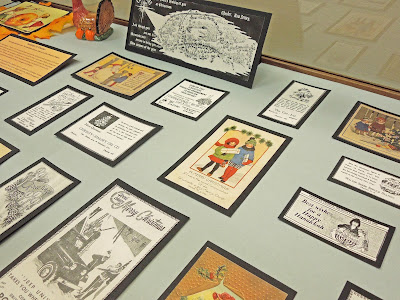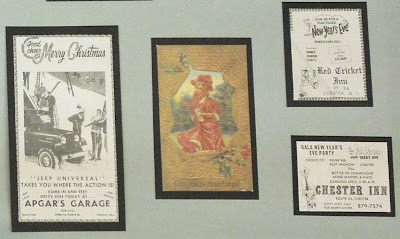| From Plainfield Public Library Detwiller Architectural Drawings Exhibit 2014 |
The Big Exhibit
Shown above is the terrific Charles H. Detwiller, Jr. Architectural Drawings Collection exhibit at Plainfield Public Library created by Sarah Hull, Senior Archivist and Head of Local History, Special Collections and Genealogy; Jeff Wassen, Visual Materials and Exhibition Coordinator; Jane Thoner, Genealogy Librarian; and Sandy Gurshman, Special Collections and Reference Librarian. My contribution to this impressive display (which covers walls in the main reading room, Plainfield Room, and Meeting Room 2, as well as 4 exhibit cases) took place much earlier during my processing of the collection favorites in 2010 and 2011. The favorites are a small percentage of the now 16,000 sets of architectural drawings that represent each of the Plainfield architects, each type of structure in the city, and the best examples to use for exhibits.
When I took on that project, I applied the condition-reporting techniques I'd learned working at the Zimmerli Museum. My documentation included, among other things, taking measurements of each set and making recommendations for future exhibits. At the time, I didn't know where I would be working when those objects would be displayed, but I did know that the information I collected would be useful at some point. Since beginning his work on the exhibit, Jeff has let me know that my measurements, recommendations, and information slips kept with the rolled blueprints/drawings were helpful in their decision-making process.
 |
| From Plainfield Public Library Detwiller Architectural Drawings Exhibit 2014 |
The exhibit is extraordinary. It covers a wide range of architectural styles from the first building permit in 1896 to mid-century split-levels (the collection itself spans nearly 150 years). There are houses of worship, schools, homes of different types, apartments, stores, and even a drawing of a fancy snack cart for Muhlenberg Hospital. Below is a truly unique example -- a Central Railroad of New Jersey documentation of a train derailment in Cranford from 1924.
 |
| From Plainfield Public Library Detwiller Architectural Drawings Exhibit 2014 |
There are 25 architects' work on display. The archivists and librarians were able to locate information on 11 of them. For example, Col. Evarts J. Tracy, Jr. lived from 1868-1922 and was the great-great grandson of Roger Sherman, who signed the Declaration of Independence and the Constitution. Then there was Oscar S. Teale (1848-1927), who wasn't just a Plainfield architect, he moonlighted as a magician known as "Ottilidio," and called Houdini a close friend.
 |
| From Plainfield Public Library Detwiller Architectural Drawings Exhibit 2014 |
While those are notable stories, one of my favorite architects in the collection is Augustus L.C. Marsh (1865-1942). His attention to detail and flourish made his designs and talent famous with the wealthy families of Plainfield, as well as New York City, where he worked at the firm Marsh & Gette until he moved his offices to Plainfield.
 |
| From Plainfield Public Library Detwiller Architectural Drawings Exhibit 2014 |
The great collector and architect Charles H. Detwiller, Jr. (1916-1991) (shown above) saved this collection from certain ruin. As the story goes, Plainfield had been storing all the drawings and blueprints at the Wardlaw School until Wardlaw moved to Edison and the duCret School of Art bought the building. The city would have disposed of all the historical documents had it not been for Charles Detwiller. Son of an architect and father of two architects, Detwiller rented a storage facility for the thousands of sets of plans to save them for future generations until he donated them to the library in 1982.
Detwiller worked on many historical preservation projects including the Drake House in Plainfield, East Jersey Olde Towne in Piscataway, and others along the Atlantic coast. His residential works make up a fair amount of the collection. I've worked with many of the now fragile and acidic sketches of additions and new homes in locations as far flung as Montana (where he designed a fishing library with shelves bolstered by carved wooden fish). He's also the man behind the fancy snack cart I mentioned earlier.
 |
| From Plainfield Public Library Detwiller Architectural Drawings Exhibit 2014 |
I am sorry that I didn't have the opportunity to meet Charles Detwiller. Because I've spent so much time with his collection, as well as his own work, there are questions I wish I could ask him. For instance, what types of concerns arise when you speak with a client about the miniature golf course he wants for his garage (see the image below).
 |
| From Plainfield Public Library Detwiller Architectural Drawings Exhibit 2014 |
The Third Gig
Speaking of Detwiller, he and his wife Catherine also were active members of the Plainfield Historical Society (PHS). Earlier this year, PHS wrote me into a small grant to take a survey of their collection, make recommendations to bring the collections under intellectual and physical control, and do some processing (time permitting). I'm still at PHS one day per week, and very much enjoying the small and large discoveries in the Drake House. The volunteers and staff are lovely people who are dedicated to making the House and its collections more accessible and interesting to its visitors. On many a Sunday, I find much-needed and long missing photos of the House during a pivotal time period or a letter giving more insight into the relationship between a famous spinster and her mentor. Each week, there is an exciting new discovery, and I'm very grateful to be a part of that excitement.
Other Work News
Additionally, I recently celebrated two years as the Local History Librarian at Chester Library. The universe's gift to me on the occasion was to send a wonderful 83-year-old lifelong resident to me with a collection of postcards. It seems to be our trend now to digitize items on loan to us in order to increase their accessibility to our patrons both far and wide. His collection is no different, although this time, I have the great pleasure of video recording our patron talking about his Chester postcards and what the town was like during the 1940s and 1950s. My plan is to post an online exhibit on the postcards (much like this one), and add these short oral histories to each postcard page. I think it will add a wonderful new dimension to experiencing these postcards of Chester.
Our patron also has lent us his collection of The Mendham-Chester Tribune newspapers to digitize. I'm in the process of writing a grant for that project. Those papers add to our current collection of local papers and fill in an important gap -- the 1936-1939 time period. I can't wait to read those papers!
Overall, it's been an exciting time at Chester Library. This week, I give a Genealogy 101 presentation and have another video recording session with our soon-to-be internet sensation. He really is a natural at it. I'll be posting a link to the exhibit here when it's available. Because he has many postcards and we're taking quite a bit of footage, I expect the finished exhibit will be online in early 2015.
Until then, I encourage you to visit the Plainfield Public Library at 800 Park Avenue in Plainfield, NJ to see the remarkable Charles H. Detwiller, Jr. Architectural Drawings Collection exhibit. It will be available for viewing until November.










